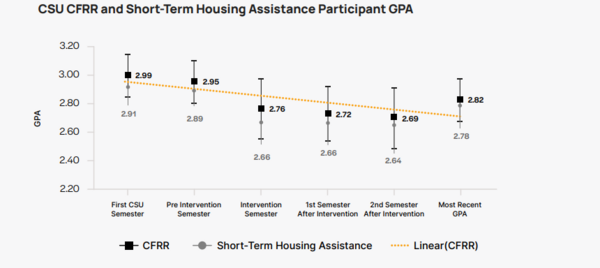Inside Higher Ed
An estimated 20 percent of college students experience housing insecurity and 14 percent experience homelessness, according to fall 2024 data from Trellis Strategies. Yet many colleges are ill-equipped to address student housing concerns, particularly institutions with nonresidential campuses or those that serve adult learners.
The state of California created an initiative in 2020 to provide housing and short-term support to students who were experiencing housing insecurity while enrolled at one of the three public systems—the California State Universities, California Community Colleges or the University of California.
A recently published analysis of the state’s College Focused Rapid Rehousing (CFRR) program identified promising practices and lessons learned from the pilot. The study—authored by the Center for Equitable Higher Education (CEHE) at California State University, Long Beach—found that students who participated were more likely to remain enrolled and graduate compared to their peers, and a majority had established stable housing one year later.
The background: Passed in July 2019, Assembly Bill 74 allocated funding for college-focused rapid rehousing programs, which give students rental subsidies, moving assistance, wraparound supports, case management and emergency grants. The community college system received $9 million, CSU $6.5 million and UC institutions $3.5 million to invest in long- and short-term initiatives, depending on each system’s unique student needs.
According to 2023 data included in the report, over half of CSU students and 65 percent of CCC’s who receive financial aid experience housing insecurity. One-quarter of CCC students and 11 percent of CSU students experienced homelessness during the 2022–23 academic year.
The CEHE study evaluated the program over three years at eight CSU campuses and two community colleges. In total, 639 students participated in CFRR across the 10 institutions, and 3,949 received short-term assistance—often in the form of an emergency grant—from spring 2020 to spring 2024. Approximately 540 students fell into both categories, receiving short-term support before enrolling in CFRR.
Some historically underserved populations were more likely to participate in CFRR: Black students and former foster youth were heavily overrepresented relative to the general population, and first-generation, transfer and returning students were also overrepresented to a smaller degree.
Addressing housing insecurity: The program was successful in its goal of mitigating homelessness for enrolled students. After engaging with CFRR, participants experienced substantial housing stability, with an average of nine consecutive months of housing.
In addition, a majority of students who left the program graduated (27 percent) or reached permanent housing (27 percent), while 15 percent failed to meet academic requirements, which is a common barrier to sustaining housing assistance.
The greatest share of students (37 percent) were placed in stable housing in less than six months, though one-third took over 12 months to get housing from a community partner. The breakdown highlights the challenges in placing students in viable housing options, according to the report. However, two-thirds of surveyed students (n=181) said they believe they had been housed relatively quickly.
One year after exiting the program, a majority of participants indicated that they were residing in an apartment or home that they directly leased or owned. Eighteen percent lived with a family member.
Students credited the program with supporting their long-term success; 71 percent of survey respondents agreed or strongly agreed that their current housing situation was better because of the assistance they received.
However, many still struggled with financial insecurity. Sixty-two percent said it was difficult to pay increased rent in the first year after exiting the program, and 25 percent underpaid or missed at least one rent payment during this period. Three in 10 said they had to move more than twice due to financial difficulties, and one-quarter of program graduates reported at least one episode of homelessness.
Impacting student success: In addition to meeting students’ basic needs, the program had a demonstrated effect on persistence and attainment rates.
Participants were more likely to remain enrolled or graduate (56 percent) compared to students receiving short-term housing assistance (47 percent). At CSU, CFRR students graduated within four years at higher rates than the broader CSU population (43 percent versus 35.5 percent), as well.
Data also pointed to the impact housing crises can have on students’ academic performance, with housing-insecure students reporting their lowest GPA the semester they engaged in support interventions and the semester following.
A graph showing the average GPA of CFRR participants compared to their peers who received short-term assistance from their institution.
Twelve months after receiving assistance, CFRR students were significantly less likely to stop out of school compared to their peers who received just a short-term housing subsidy. Survey data showed students were more likely to engage in school activities, but a majority (70 percent) still held jobs to pay for college, working an average of 25 hours per week. Eighty percent of CFRR participants said they had difficulty balancing school and life responsibilities.
Program participants were also more likely to be employed six months after entering housing (70 percent) versus three months before entering the program (56 percent).
Housing insecurity can damage students’ mental health and in turn affect their persistence in higher education. At intake into CFRR, 76 percent of participants said they felt lonely, but that number dropped to 63 percent in follow-up surveys. Just under half of housing-insecure students experienced serious psychological distress at intake, while closer to one-third indicated distress at follow-up. These numbers remain elevated compared to the total student population at CSU, where 20 percent experienced serious psychological distress.
The program also increased students’ emotional and mental resilience. Students rated their ability to handle personal problems higher after securing housing as well, from 33 percent to 52 percent during follow-up.
If your student success program has a unique feature or twist, we’d like to know about it. Click here to submit.
Source link
Ashley Mowreader
#Housing #Program #Increases #Student #Success #Calif
